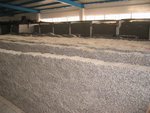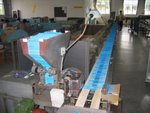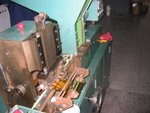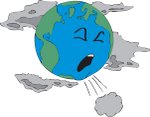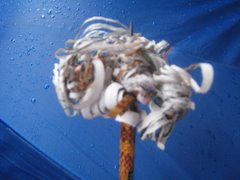Many have written to ask how we make our pencils. The process of making a recycled newspaper pencil is relatively easy if you happen to have the secret formula, exclusive machines, 40 staff, a large building and a commitment to excellence. It is really simple to make a cheap, toxic and crappy recycled newspaper pencil. There are plenty of imitations and "fly by night" factories doing this right now. Even though they try, no one comes close to the O'BON recycled newspaper pencil. Enough...let's describe the process.
It all starts with the newspaper. The used newspaper has to be cleaned and pressed out so that each paper, each sheet is absolutely flat. There can be no crinkles and lines as well as no chewing gum. Crumbled paper won't do. In short, the used newspaper has to be clean and flat. Once our team goes through each sheet for cleanliness, the paper is laid flat and stacked. Then a two ton flat concrete block is lowered to press the paper flat. The weight stays for a least a week.
Once the old newspaper is flatten, we cut it to the precise length of a pencil. One sheet of standard newspaper is cut into six sheets, thus six pencils can be made from one sheet of newspaper. The length is long enough for 70 revolutions (wrap around the graphite. We often add an additional small length of recycled plain paper for pencil we plan to paint.
Once the paper is cut and stacked, the pile of newspaper heads to another room to be wrapped and glued. First a half inch fold is made at the top of the paper and the graphite with a small amount of non-toxic, water based glue is added. These are stacked into groups of one thousand. These are carried over to the nearby first machine which thread the graphite filled newsprint into a machine that wrap the pencil. The key to this process is that a small amount of water based glue is dripped onto the newspaper as the machine wraps the pencil tight. So, with each revolution of the newspaper some glue is added. This gives the O'BON pencil a tight, solid, firm feel as the glue hardens.
The hardening of the O'BON pencil involves two steps. First we place the pencils on racks so they can air dry. They will sit on this rack for one to two days. After air drying, the pencils are taken to a big machine where they are heated to 60 degrees Celsius (that's hot). They will be hot air dried in this machine for four hours. This process hardens the glue so the pencil's characteristics are solid and firm.
Out of the heater, the pencil looks rough. It has rough edges and the ends are ragged. So, we sand them smooth and cut off the ends. The machines that sand the pencils and make the O'BON pencil smooth are quiet, and the newspaper dust is collected from the sanding basket and blown into large water vats. Here the newspaper dust turn into a harmless sludge which is filtered. We put the dried remains on our vegetable garden and as mulch around our surrounding trees.
Now the smooth, firm pencil is ready to be painted. We have two systems for this. We have machines that print on our world famous "art." We make high quality film that prints on the pencil our Tiger, Leopard, Elephant, Bear and Parrot. This is how we get our high quality print on the pencil. The other system is where the pencil is painted a single color. The pencils are forced through a small box filled with the paint. As the pencil comes through the box, the excess paint is scraped off with flexible plastic rings. The pencil then rests on a long conveyor belt and the fine layer of paint is given time to dry as it circles on the belt. Then it is forced through the paint box again. A total of at least ten circles and paint layers for each pencil results in an ultra smooth painted surface.
After the paint is applied, the ends are sanded creating a small inverted indentation. The pencils are put upside down into a holder. There will be a hundred pencils in each holder. The holder is lowered (usually less than one inch) into a big vat of paint. Because of the indentation on the end, the dip into the paint results in a smooth and stunningly beautiful "cap." It isn't a cap, but it sure looks like it.
Once dried from the dip, the O'BON pencil is ready to be gently nestled into it's box.
Tuesday, October 27, 2009
Subscribe to:
Posts (Atom)




